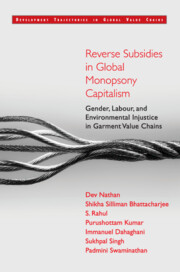 Reverse Subsidies in Global Monopsony Capitalism
Reverse Subsidies in Global Monopsony Capitalism 7 - Rural Subsidies
Published online by Cambridge University Press: 21 January 2022
Summary
Introduction
Wages below living wages are a subsidy to capital, reducing wage costs. Since in such global value chains (GVCs) the surplus profits are captured by the brands, while suppliers basically get competitive profits, it is the brands that benefit from wages below the cost of production of labour power. But what is the form of this subsidy in social reproduction? Who bears the cost of this subsidy in the reproduction of labour power? The subsidy takes two forms—one is by the mining of women workers’ bodies and the policy of ‘overuse and discard’ of, particularly, women workers in garment factories when they age out of employment; and the other is by externalizing part of the cost of reproducing labour power from the factory and displacing it onto the rural economy of the households of migrant workers. The extractive labour subsidy achieved by mining of workers’ bodies was dealt with in Chapters 5 and 6. The rural subsidy in the reproduction of labour power is dealt with in this chapter.
There is yet another rural labour subsidy involved, which is in the production of cotton. This is through, first, low prices of cotton, which do not cover its cost of production, because farmer incomes are insufficient to meet the basic justice requirements of supporting elementary capabilities. The second is wage labour, including child labour, in cotton production that again violates basic justice requirements. This chapter begins with the rural connection of garment workers and then goes on to labour subsidies in cotton production.
Before proceeding to look at other forms of labour subsidies, we note an analytical issue in GVC analysis. GVC analysis is embedded (Gereffi 2019) in, meaning connected with, local economic and social processes. However, most GVC analysis tends to remain within the confines of the core factory—interrogating the relation of buyers and suppliers and of workers in supplier firms with their employers. At best, labour market conditions within which GVC labour takes place are included as a subject of analysis. This chapter shows that there is a need to look beyond the GVC itself to understand its functioning and dynamics.
- Type
- Chapter
- Information
- Reverse Subsidies in Global Monopsony CapitalismGender, Labour, and Environmental Injustice in Garment Value Chains, pp. 132 - 153Publisher: Cambridge University PressPrint publication year: 2022


